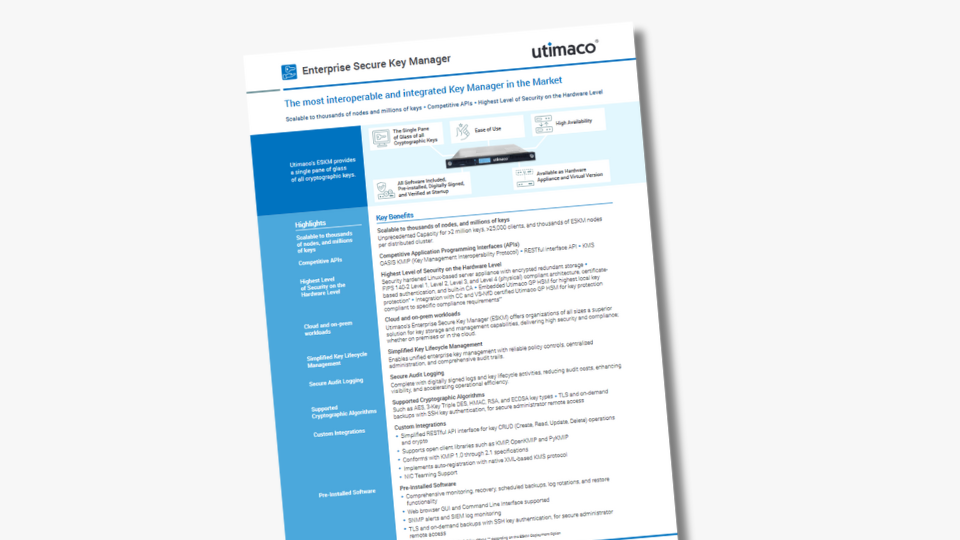Securing entire digital ecosystems might seem challenging but can be simplified by leveraging the principles of complete key lifecycle management.
Cryptographic key management is essential for safeguarding sensitive data and ensuring secure access to digital environments. It involves overseeing the entire lifecycle of cryptographic keys - from generation to final destruction -to ensure security and compliance at every stage.
Poorly managed keys can expose organizations to data breaches, corruption, or regulatory penalties. This blog outlines the critical lifecycle stages of cryptographic keys and explores how their management can be streamlined and secured through utilization of the right solutions.
Stages of Key Management: From Generation to Destruction
Cryptographic keys are vital for encrypting, decrypting, digitally signing data, as well as controlling access to data, information or entities in digital infrastructures.
Managing cryptographic keys throughout their lifecycle, from creation to secure destruction, is essential for protecting sensitive data, maintaining compliance, and following key management best practices.
Below are the ten essential stages of key management, each highlighting the need for a reliable, centralized and secure system.
The Stages of Cryptographic Key Lifecycle Management
1. Key Generation
Keys must be generated in a secure, controlled environment using high-quality random key generation processes.
Why it matters: Weak or predictable keys can compromise data security. Secure key management systems ensure that keys are created in the most secure and reliable way.
2. Secure Sharing
Keys must be securely distributed to authorized users or systems, sometimes also across heterogenous environments. The security of the keys during transit is essential.
Why it matters: Insecure sharing methods might expose keys or make it easy to intercept them. Centralized systems enforce secure sharing protocols between endpoints.
3. Authorized Usage
Keys are activated for operations such as encryption or data signing. Access controls must limit use to authorized personnel or systems only, ensuring policies are adhered to at all times.
Why it matters: Unauthorized or improper use of keys can create vulnerabilities. Automated access controls help minimize misuse while enhancing organizational efficiency.
4. Secure Storage
Keys must be securely stored - whether they are used on-premises or in the cloud - to prevent unauthorized access. Encryption and tamperproof measures are vital.
Why it matters: Poor storage practices expose keys to theft, manipulation, or misuse. Central systems keep keys encrypted and isolated while enabling only authorized access.
5. Secure Backup
Secure backups ensure availability of the keys in case of hardware failures, corruption or other disaster scenarios. Backup files also need encryption and access controls ensuring to be protected against attacks or theft.
Why it matters: Losing a key could cause encrypted data to be inaccessible and customer or productions operations to be stopped. Secure key management systems automate encrypted backups in a highly secure way to maximize availability and reduce operational risks.
6. Automated Key Rotation
Keys should be periodically replaced to ensure the ongoing security of the data they encrypt and to limit exposure in the case of key compromise. Automation of those key rotation operations is ideal and ensures timely and secure rotations with minimal manual intervention.
Why it matters: Long-lived keys are more susceptible to attacks, especially when used to protect critical information. User-friendly and automated rotation policies within key management systems mitigate vulnerabilities efficiently while reducing manual workload.
7. Termination of Unused Keys
When keys are no longer needed, they should be securely terminated to prevent unauthorized retrieval or continued use.
Why it matters: Retaining outdated keys might lead to unintentional leaks. Centralized systems enforce proper termination protocols.
8. Key Revocation
If a key is compromised, it must be promptly revoked to prevent misuse and further damage. This includes removing it from all systems and ensuring it can never be put back into operation.
Why it matters: Revoking compromised keys minimizes potential damage from security breaches. Effective key management systems streamline immediate and permanent revocation.
9. Compliant Archiving
Some keys may need to be retained for compliance and auditing purposes over a long period of time. Archived keys must remain secure and traceable while being inaccessible to former users and unauthorized entities.
Why it matters: Improper archiving could lead to breaches or mismanagement. This makes it necessary for key management systems to keep archived keys encrypted and access-controlled.
10. Key Deletion
Keys with no further use should be securely destroyed to eliminate any future risk of exposure.
Why it matters: Failure to destroy outdated keys can result in data leaks. Holistic key management systems ensure thorough, verified destruction processes, enabling reliable end of life for crypto keys.
Why Centralized Key Management Matters
Managing each phase of a cryptographic key’s lifecycle independently can be inefficient and error prone. A centralized approach streamlines operations while offering a unified interface to oversee all keys throughout their entire lifecycle. Beyond streamlining workflows, this ensures compliance with security and compliance standards, reduces manual intervention, and establishes audit trails for accountability.
Simplifying Management of Cryptographic Keys Throughout Their Complete Lifecycle
Utimaco’s Enterprise Secure Key Manager (ESKM) is a holistic key management system enabling central access, management and storage for all cryptographic keys at each stage of their lifecycle through one single pane of glass.
With that, it is the ultimate solution for complete key lifecycle management, enhancing security and operational efficiency.
Wrapping It All Up: Key Takeaways
Cryptographic key lifecycle management is a critical practice for protecting sensitive information as the security level of digital environments is determined by the security of the cryptographic keys used to protect them.
From generation through destruction, each stage of a key lifecycle management is vital in preventing vulnerabilities and ensuring operational continuity.
The right key management system provides a reliable, scalable, and centralized platform for managing the entire lifecycle for all cryptographic keys.
With ESKM, businesses gain advanced security while simplifying operations, making it a compelling choice for safeguarding their digital assets.
Ready to strengthen your cryptographic key management?






